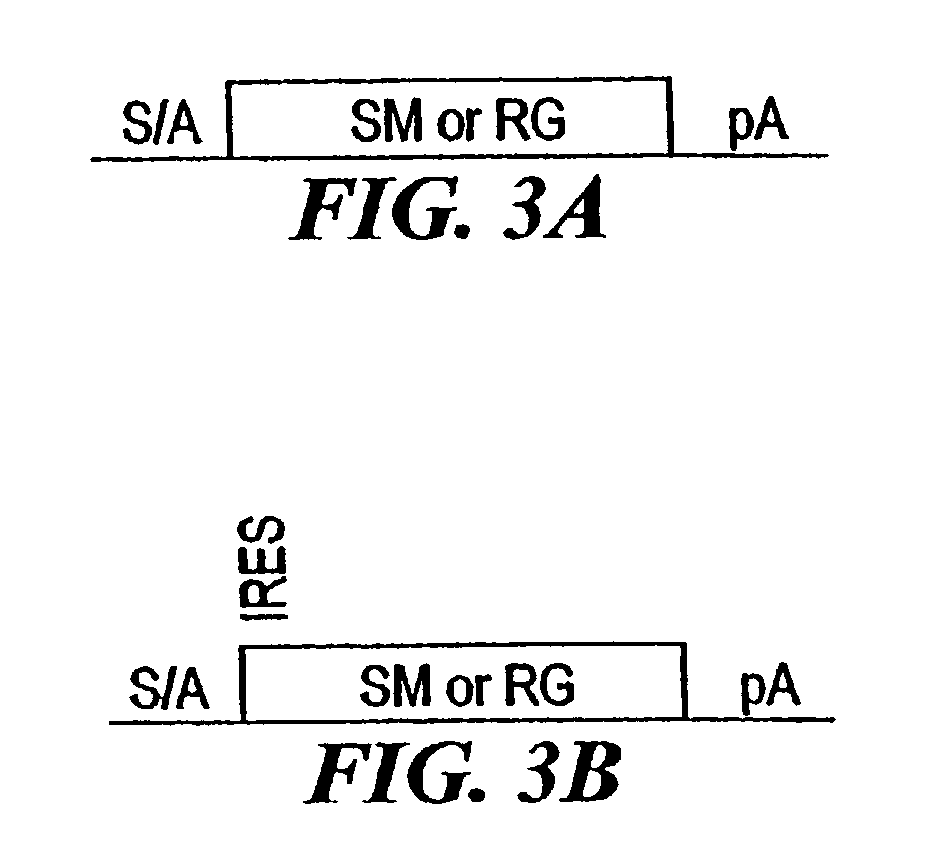Compositions and methods for making mutations in cell lines and animals
a technology of cell lines and animals, applied in the field of cell line and animal mutations, can solve the problems of difficult or impossible identification of chemically mutated genes, inability to efficiently produce cell mutations, and inability to tag mutated genes
- Summary
- Abstract
- Description
- Claims
- Application Information
AI Technical Summary
Benefits of technology
Problems solved by technology
Method used
Image
Examples
example 1
Combined Mutagenesis of Embryonic Stem Cells
[0208]Embryonic stem cells (RI) (Nagy et al., Proc. Natl. Acad. Sci. USA 90:8424-8428 (1990)) are cultured on feeder cells or gelatin coated plates at 37EC in a humidified incubator with 7.5% CO2. The cells are cultured in D-MEM / 15% FBS / 0.1 mM β-mercaptoethanol / Leukemia Inhibitory Factor (1000 U / ml) / non-essential amino acids. The cells are grown to 80% confluence. In 10 plates, each containing approximately 4×106 cells, O6-benzylguanine (O6-BG) is diluted in DMSO and added to the media to 10 μM final concentration. To a separate 10 plates, no O6-BG is added. Following a 12-16 hour incubation, cells from each plates are trypsinized, diluted to 5×106 cells / ml, and incubated with various concentrations of ENU for 1 or 2 hours. ENU concentrations were 0.2 mg / ml, 0.3 mg / ml, 0.35 mg / ml, and 0.4 mg / ml. The cells that are pretreated with O6-BG were incubated with O6-BG during the ENU treatment. Following treatment, cells from each ENU treatment ar...
example 2
Combined Mutagenesis of Jurkat Cells
Cellular Screen to Identify Gene Knockouts that cause Resistance to FasL-Induced Apoptosis in Jurkat Cells
[0210]The combined mutagenesis technology described in this application was developed to speed the discovery of gene function in mammalian cell culture by coupling distinct mutagenesis techniques to efficiently generate phenotypes and simultaneously enable the facile identification of gene mutations that cause these phenotypes, combined mutagenesis combines the strengths of various mutagenic approaches to compensate for distinct deficiencies of each of the individual mutagenesis techniques. The embodiment of combined mutagenesis that is described here uses the following sequence of steps to identify cell based gene function (illustrated in FIG. 1):[0211]high density ENU mutagenesis of cells in culture; creates compact libraries of cells that contain mutations in nearly all genes[0212]select only those ENU mutagenized clones for further gene tr...
PUM
| Property | Measurement | Unit |
|---|---|---|
| mutation frequency | aaaaa | aaaaa |
| physiological disorder | aaaaa | aaaaa |
| resistance | aaaaa | aaaaa |
Abstract
Description
Claims
Application Information
 Login to View More
Login to View More - R&D
- Intellectual Property
- Life Sciences
- Materials
- Tech Scout
- Unparalleled Data Quality
- Higher Quality Content
- 60% Fewer Hallucinations
Browse by: Latest US Patents, China's latest patents, Technical Efficacy Thesaurus, Application Domain, Technology Topic, Popular Technical Reports.
© 2025 PatSnap. All rights reserved.Legal|Privacy policy|Modern Slavery Act Transparency Statement|Sitemap|About US| Contact US: help@patsnap.com



